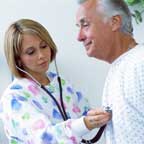
Approximately 12 million people suffer from Chronic Obstructive Pulmonary Disease (COPD), and 64,000 women die from it each year. In fact, COPD is the fourth leading cause of death among women, right after heart disease, cancer, and stroke. As a reminder, one of the key factors in preventing each of these leading killers is to avoid smoking and secondhand smoke.
COPD is a category of long-term, irreversible diseases that make breathing difficult. These diseases include chronic bronchitis and emphysema. Not only does COPD have a negative effect on a person’s quality of life, but it eventually worsens and can lead to heart problems, severe dyspnea (shortness of breath), and ultimately death. While there’s no cure for COPD, it’s sometimes possible to manage and treat some of the symptoms.
Managing COPD
The first and most important thing anyone can do to manage COPD is to stop smoking—not just cigarettes, but also cigars and pipes. Improving overall health through proper diet and moderate exercise also can be beneficial. For most patients, additional measures are needed to help manage their COPD.
In some cases, patients are prescribed either a bronchodilator (a medication that relaxes/dilates the bronchial tubes) or a corticosteroid (a substance similar to natural hormones that helps manage various body functions. Examples include prednisone, dexamethasone, and hydrocortisone.
Both of these types of medication are usually given through an inhaler or nebulizer, although bronchodilators occasionally are given orally or as an injection. An inhaler is a handheld device that delivers a puff of medication through the mouth. A nebulizer delivers the medicine directly to the patient’s airways and lungs through a mask or mouthpiece. These medications are used to reduce shortness of breath and control wheezing or excessive coughing.
Surgical Treatment
When lifestyle changes and medications don’t provide relief, surgery may become an option. A qualified surgeon can help you determine the best way to treat your COPD. A lung transplant is one possibility; however, it isn’t appropriate for everyone. In addition to the long waiting lists for a donor lung, there are also health considerations that must be taken into account before pursuing a transplant.
A second option for treating emphysema is lung volume reduction surgery (LVRS). This surgery involves removing the diseased portion of one or both lungs, which allows the healthy part of the lung to expand and work more efficiently. To determine a patient’s eligibility for LVRS, the surgeon looks at several factors including:
• Age (usually under 75).
• Severity of emphysema (unresponsive to traditional medical treatment).
• Smoking status (non-smoker for at least six months).
• Location of disease in the lung (specific targetable areas of disease that don’t include the entire lung).
• Severity of difficulty breathing (as measured in forced expiratory volume).
• Awareness and understanding of potential surgical outcomes.
LVRS Research Results
LVRS first was introduced in the 1950s as a treatment for emphysema. At that time, the surgery didn’t provide consistent results. Therefore, it wasn’t a widely used procedure in its early years.
Since then, research has been done to determine whether it’s an appropriate surgery and which patients make the best candidates for optimum results. One of the most widely reported studies is the National Emphysema Treatment Trial (NETT).
The five-year trial was conducted at 17 clinical sites. It measured mortality, lung function, quality of life, dyspnea, and illness. In general, patients with severe emphysema who underwent LVRS, along with medical therapy, achieved better results than patients who received only medical therapy. Although these general results provide a good basis of information, individual patient results varied.
LVRS patients typically improved lung function and quality of life, as well as reported fewer symptoms compared to those who received medical therapy alone. The non-high-risk survivors in the LVRS category initially improved their scores in lung function, quality of life, and dyspnea. At the end of two years, the scores declined to levels comparable to those prior to surgery. Patients in the medical therapy only group had scores that continued to decline during that same two years, with functional levels ultimately below where they started.
The risk of death within three months for patients who had LVRS, along with medical therapy, was slightly higher than for patients who had only medical therapy. However, the overall death rate for both groups was the same at the end of the 29 months of follow-up. Patients with severe lung obstruction were identified as being at a higher risk and were, therefore, no longer enrolled in the later stages of the study.
This type of research helps to continually further the possibilities for improving quality of life among patients with COPD. It also reinforces the importance of properly matching patients to the treatment best suited to their individual situations. TPW
